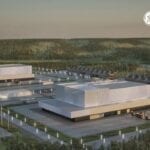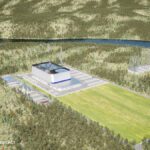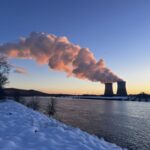Constructing a new nuclear power plant is a massive undertaking. It involves years of planning and countless hurdles just to get the necessary regulatory approval to break ground. Once physical work begins, risks abound, and delays and cost overruns seem to be the norm rather than the exception. In the end, almost half of all nuclear reactors ordered in the U.S. have not been completed, leaving more than a few companies bankrupt in the process.
There are a couple of ways to look at the economics of nuclear power. On one hand, it makes sense that bigger is better. After all, if you’ve taken a basic economics course, you probably learned about economies of scale. But with size comes complexity—managing a complicated multibillion-dollar project is no small task. Thus, some experts have argued that the scaling benefits do not apply to nuclear power plants and smaller units actually cost less, even on a per-MW basis.
Small Modular Reactors
There’s been a lot of ballyhoo about small modular reactors (SMRs) over the past 10 years or more. POWER has published numerous articles during that time detailing features of various SMR designs. Yet, none of the companies touting SMR technology has built a single commercial unit in the U.S. Nonetheless, there are a few utilities keeping their options open.
The Tennessee Valley Authority (TVA) is one power provider that has been looking into SMR designs. Mike Skaggs, executive vice president of operations with TVA, spoke with me during the ELECTRIC POWER Conference and Exhibition in Nashville, Tennessee, on March 20. He said TVA is “cautiously participating” in SMR discussions. According to Skaggs, TVA believes SMRs are “moderately viable,” but it doesn’t plan to construct one in the next 10 to 20 years.
Dan Stout, senior manager-SMR Technology with TVA, gave a presentation at the event and spoke with me afterward. He suggested work still needs to be done to reduce uncertainties before any utility would commit to ordering an SMR. “[One] of the lessons learned of the more-recent [large reactor] projects is: Get the design more mature before you begin construction,” Stout said. Several companies are trying to do just that.
SMR Designs
The design farthest along in the U.S. regulatory-approval process belongs to NuScale Power (see “Is There a Market for Small Modular Reactors?” in the June 2016 issue). The company submitted a Design Certification Application to the Nuclear Regulatory Commission (NRC) on December 31, 2016, which was accepted for review on March 15, 2017. NuScale expects the NRC to complete the review and approve the design by September 2020. The company has a preliminary agreement with Utah Associated Municipal Power Systems (UAMPS) for the first commercial NuScale power plant to be constructed on the Idaho National Laboratory site. Energy Northwest—owner and operator of the Columbia nuclear plant in Washington—would operate the facility for UAMPS.
In July 2017, Holtec International signed a partnership agreement with SNC-Lavalin, designed to “vigorously accelerate” development and licensing efforts for its SMR-160 design. The SMR‐160 is a single-loop, 160-MWe pressurized water reactor based on existing light water technologies. Holtec announced in February that it would collaborate with GE Hitachi Nuclear Energy (GEH) and Global Nuclear Fuel (GNF, a GE-led joint venture with Hitachi Ltd. and Toshiba Corp.) to advance the SMR-160. The cooperation initially includes nuclear fuel development supported by GNF and control rod drive mechanisms designed by GEH. It may later extend to other areas. Holtec is also receiving design support from the Oak Ridge National Laboratory (ORNL) through a $500,000 voucher awarded last June by the U.S. Department of Energy.
During the ELECTRIC POWER show, Robin Rickman, vice president of business development for Terrestrial Energy, offered details about a less-conventional advanced nuclear design. He was touting Terrestrial’s 400-MWth (192-MWe) liquid-fueled SMR. Called the IMSR (Integral Molten Salt Reactor), it incorporates many aspects of molten salt reactor operation researched, demonstrated, and proven in test reactors at ORNL in the 1960s.
“[There are] thousands of hours of operational expertise on this particular technology,” Rickman said. “We can talk for hours on why it was curtailed, but it had nothing to do with the technology,” he added.
In the IMSR, uranium is dissolved in common fluoride salts to create the liquid fuel. The reactor operates at atmospheric pressure with a temperature of 704C (1,300F). After startup, the reactor is designed to run continuously for seven years, after which, the liquid-fuel salts are expelled to a storage cask contained in the reactor compartment where it would remain for the life of the plant. The core unit would be removed from the operating silo and replaced with a brand-new core unit. That would be operated for the next seven years and the cycle repeated for a minimum of 56 years.
Several other SMR designs are also under development.
Are We There Yet?
Navigating the regulatory obstacles to get an SMR design approved is certain to be difficult and time-consuming. Nonetheless, cost remains the biggest hurdle. If delays and cost overruns plague small units the way they have larger ones, SMRs are very likely to be dead on arrival.
However, TVA’s Stout offered reasons for optimism. Once a plant is built, nuclear fuel costs are relatively low, capacity factors are generally high, grid stability is enhanced, and the power is carbon-free. Compared to large reactors, SMRs offer improved safety and security, reduced total capital costs, easier project management, a lower risk profile, more flexibility, and increased siting options.
Can we get there from here? My GPS is still recalculating. ■
—Aaron Larson is POWER’s executive editor.









